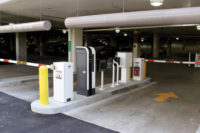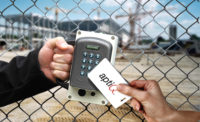Parking is often an important part of a security installation, but not always the first thing that comes to mind when you think about cutting-edge technology or innovative ideas. However, parking lots and garages can and do present some unique challenges to the integrator.
Technology for parking security runs the gamut from parking arms and bollards to cameras, long-range readers and emergency call stations, to name just a few. Parking lots and garages can be manned or unmanned, 24-hour or not, high, medium or low security. What they have in common is that they present risks to employees, visitors and property and often are magnets for crimes of opportunity, theft, or worse. Visitors and employees can feel the most unsafe in parking lots or garages, because they are large spaces with few people around.
Current trends in parking access rely more and more on automated systems, whether it is pay-on-foot stations that use credit cards, unmanned parking gates, or long-range RFID that opens the gate from a distance. These trends save money in labor. However, other technologies also are needed to provide the security and safety elements. Video cameras and emergency call stations are increasingly popular items in parking lots and garages.
SDM spoke with integrators about their most recent or upcoming parking-related installations. Across the board, they all include a combination of automated convenience and safety measures that reflect these trends. Some are completely unmanned applications, while others employ a combination of manned and new technology.
Unmanned Applications
“We are seeing a strong trend to reducing manpower to reduce long-term costs,” says Roger Miller, vice president, Northeastern Protection Service Inc., Dartmouth, Nova Scotia, Canada. “We have worked with some of our clients on finding ways to reduce costs through automated systems in situations where there was once a manned booth. But, they also have to look at other levels of automation. They don’t want to be perceived as unsafe because there are no people in a booth and no panic stations. That will drive business traffic to some other parking facility.”
One of Miller’s clients is Scotia Square Parkade in downtown Halifax. The 40-year-old property had been updated many times but never had been equipped with panic stations (see “The Challenge: Hardwired Panic Stations” below). The garage has eight levels with 1,700 spaces and is open 24 hours a day, with multiple access points. Before going to the security trade shows last year, Miller asked his client if there was anything they were looking for. Scotia Square wanted to find panic stations that could handle more than one call at a time, so that if calls came in from more than one location they would be answered immediately and responded to.
Because most panic stations rely on phone lines, this was a difficult request, but Aiphone Corp., Bellevue, Wash., had recently launched a new product that operates over Cat 6 wiring.
“There are no phone lines in this garage,” Miller says. “With this product they can get video and audio of the caller, and everything is wired from the actual panic station back to the main control room.” It also met the simultaneous calling requirement because it was not dependent on phone lines.
“This is really the only security in the parking garage. They have automated pay stations and automated gates. Nothing is manned.”
This was also the case at a recent installation completed by Convergint Technologies LLC, Schaumburg, Ill., in a Texas hospital parking lot.
“Most of my clients are large healthcare and industrial facilities and we do a lot of parking control for the healthcare industry,” says Kelle Shanks, account manager in the Convergint Dallas office. “In healthcare it is about security for their personnel and visitors. There are a lot of women who work in healthcare, and safety is a big concern.”
At Cook Children’s Medical Center, Fort Worth, Texas, a large expansion meant expanding an existing parking structure, a project that involved integrating video with emergency call stations from Talk-a-Phone, based in Niles, Ill.
“What is unique about these intercoms is they are two-way communication tied into the video system,” Shanks says. “If someone hits the intercom, the camera in closest proximity will target that station so the central station has a visual of what is going on.”
Another trend the integrator is seeing is long-range RFID for vehicles, which is another technology Cook incorporated, says Steve Payne, senior integrated systems estimator for Convergint. “People want technology in their vehicle without having a secondary tag. Plus, garages are more often a combination of revenue and personnel parking so we are having to interface with the revenue side of the equipment, as well as bringing it into the card access.”
Cook Children’s was one of these situations, Shanks adds. “In a hospital setting there is so much moving and changing going on that you need to be able to take the parking from an employee to just patient parking. It needs to be designed to change from one to the other.”
Even though this was new construction, there was very careful coordination and planning. “There is not much room for error in a parking garage because of its static nature,” Shanks says. And in this case, there was an added challenge of a helipad on top of the parking structure that involved integrating the elevator controls with the Lenel access control system.
“That was a challenge on the card access side because the public use the elevators, but in the case of a medical helicopter landing, those elevators needed to be commandeered so the elevator could only be used for authorized personnel,” Payne describes.
Elevator issues plagued a large convention center in a very different way, says Joseph Masciocco, president, Security Integrations, Albany, N.Y. With a mix of staff and visitor lots, the convention center shifted to a pay-on-foot scenario, with a ticket machine that requires visitors to pre-pay before entering their vehicle to exit the structure.
“Years ago there used to be an attendant in the booth on the way out,” he says. “But that had many layers of problems. It slowed things down, with 10 to 12 cars backed up during peak traffic times. Secondly, adding payment and management out there in the field opened up that attendant to security problems because there is cash involved.”
The pay-on-foot station was thought to be a solution to that, and the convention center put two machines in the lobby and one down in the parking area, thinking it would be simpler.
“After a while it became evident that folks only remembered to pay for parking when they were back at their car, which left only the one machine down on that level,” Masciocco explains. “If it wasn’t operating or if there was a long line, visitors had to get back on the elevator and go up to the lobby, which was not a good customer experience.” In addition, because one machine was being used much more often, there were maintenance issues.
Security Integrations is in the process of proposing a more efficient solution, using two machines side by side at the parking level, instead of split on two levels.
Manned Applications
While many parking installations today do not involve personnel at the parking booth anymore, that does not mean that the human guard concept has gone away, or that facilities still using this method aren’t also applying innovative technologies.
“The trend towards upgrading security in parking lots is very, very real,” Masciocco says. “Companies today feel responsible to offer a high level of security to visitors and staff while they are on the property in their parking lots. The megapixel technology of IP cameras is bringing things a long way.”
One of the more popular camera technology options in parking areas today is license plate readers, a solution Masciocco’s company installed last year at a large manufacturing/R&D plant in upstate New York (see “The Challenge: License Plate Readers” below). At this plant, 4,500 people enter and leave on a daily basis, from janitorial staff to Fortune 100 executives. To get people in and out quickly at peak periods, the parking gates are raised and the plant employs a security officer to visually look for the presentation of a badge on the car’s dashboard.
Built many years ago before “modern” security thinking, the plant’s parking is all on the interior of the security perimeter, making it imperative that they keep track of the cars that come and go. To accomplish this, Security Integrations installed a number of megapixel cameras from Westford, Mass.-based American Dynamics, part of the Security Products business unit of Tyco, that record in detail every car that enters or leaves, including a special camera dedicated to reading the license plate.
Then, they use a sophisticated video analytics software package from Verint Systems Inc., Melville, N.Y., that looks for vehicles that are improperly parked, or moving the wrong way.
“Because the parking is within the secure perimeter of the site, any car let in is free to roam the various parking areas on this very large campus,” Masciocco says. “If there is an incident, they needed to be able to go to the video and see which vehicles were nearby.”
At another plant, traffic flow issues prompted a very different type of solution. The Coca Cola bottling plant in Meridian, Miss., has a great number of delivery trucks and employees entering and leaving 24 hours a day. The facility had some inventory issues along with vandalism of employees’ cars and even a car theft. It turned to local integrator CUI Systems, also based in Meridian, for a solution.
An authorized dealer of DoorKing Inc., Inglewood, Calif., CUI put together a solution with the help of DoorKing’s Tony Thornton that involved fencing the entire area and using gate operators, telephone access control and both short- and long-range RFID technology.
Because the facility was located near a frontage road, there were concerns about backup, particularly of the large trucks. However, the main concerns were security and safety.
“The top concerns were inventory control and making their employees feel safer and more secure,” says Norman T. Wilson, president/owner of CUI Systems. “They are in and out all the time during the middle of the night. While there is a guard shack manned most of the day, it is not manned at night.
Employees were issued short-range proximity cards to operate the gates, but the trucks needed something more.
“The trucks have a long-range device in their windshield that recognizes the vehicle so they don’t have to stop and be stuck out in the main road,” Wilson explains. “It speeds up the flow of the system.”
CUI used loop detectors in the ground, but this quickly became complicated. The long-range readers at the guard shack weren’t reaching out far enough to pick up the trucks. After some research, it was discovered that the metal awning on the guard shack was causing interference. “We had to move them further towards the parking lot,” Wilson says. “It was a challenge to get them where we needed them.”
With 300 feet of cable and power lines, plus the fence itself, there were also issues with trenching. “Any time you start digging you run the risk of hitting something,” Wilson says. “We were putting the fence up and the installer hit the TV cable to the buildings, which caused Internet problems.”
The system used at the bottling plant is also IP-based, Wilson adds. “We are using their network to transmit from one building to the next, which makes things much more efficient.”
The Challenge: Hardwired Panic Stations
Installing panic stations at the Scotia Square Parkade in downtown Halifax presented challenges.
“You are working in a 40-year-old building and there is no conduit for this purpose,” Roger Miller, vice president, Northeastern Protection Service Inc., says. “Because these systems are hardwired, we had to run conduit through floors and ceilings and, while doing that, not interrupt the business operation. We had to work around their hazards and penetrate the floor and ceiling of the parking structure without disrupting the membranes or affecting structural security. Working in a garage is a unique challenges. There is low light, cars 24/7 and guys on ladders running pipes.”
Northeastern worked closely with the parkade’s building management team to determine where and when to drill, and went slowly and carefully. The installation took longer than expected, but the precautions were necessary to protect the public. The end result was worth it.
Technology Trends Integrators Are Noticing
Whether it is a Delta Scientific barricade paired with long-range RFID at a CarMax dealer to track vehicles automatically or a Talk-a-Phone emergency stanchion doing double duty as a mass notification device at a hospital parking lot, integrators and end users are finding more and more ways of incorporating the latest technology into their parking security applications.
“The use of long-range proximity technology is a trend we see growing within the industry,” says Norman T. Wilson at CUI Systems. “This technology allows the control of gates and parking-barrier-type systems the flexibility to allow entry and monitor the access hands-free.”
And without stopping, adds Joseph Masciocco of Security Integrations. “Long-range proximity is a good new development for the integrator. It is an opportunity to install a system that is much more user friendly. People don’t like stopping at a parking gate and presenting a card. They would much rather use an E-ZPass type scenario.”
Kelle Shanks with Convergint Technologies, agrees. “With RFID or long-range readers, people don’t have to actually pull out a card and stop. That is one trend we see. Another is mass notification. We were just awarded a contract at the University of Texas Southwest Medical Center that uses intercom/video but wanted to do to more. They are paying money for the stanchions, so they decided they might as well make them proactive as well as reactive and use them for mass communications.”
On the video side, IP and megapixel cameras are having great impacts on parking security.
“IP video has been a big help with parking facilities,” says Roger Miller of Northeastern Protection Service Inc. “Typically if you have parking equipment you have to have some sort of network running to manage that. It is much easier to install a camera if the network infrastructure is already there. You don’t have to homerun 1,000 feet of coax. It is not only about the ease of installation, but also the quality of the megapixel technology that then allows you to identify license plates or individuals.”
The challenge then becomes what to do with the information. Some integrators are seeing analytics being used in conjunction with license plate readers, while others cite challenges in identifying anomalies in a setting that by definition involves constant movement. It all depends on the needs of the customer. However, the newer technology definitely gives integrators more options.
“When you think about what parking means to an integrator, it is not just controlling cars that come and go, but also keeping track of them onsite, offering protection from vandalism on the site, and protection for employees,” Masciocco describes.
The Challenge: License Plate Readers
The installation was not without issues. “They have multiple lanes coming and going and it was a challenge getting the license plate video to record at the speed some of the cars are going in the various lighting conditions and with different license plate colors reflecting light differently,” Masciocco says. “It is not for the faint of heart. An integrator installing license plate recognition needs to do their homework and be prepared to spend some evenings tweaking the cameras.”
MORE ONLINE
For more detailed coverage of some of the technologies used in these applications, see these recent stories from SDM:








